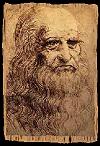|
A new notebook, commenced in 1489, concentrated on human anatomy with crude sketches of the eye, optic nerves, and the brain. Better drawings were made of the skull and eye socket. Part of Leonardo's great interest in the eye and brain came about after his experiments showed that there was a significant difference in the actual size and shape of an object and it's image as perceived by the eye. But this was a fleeting visit into anatomy and the subject was to be dropped again for about 20 years.
It was in 1508 that Leonardo really started indepth studies on the human body and how it worked; he wanted to investigate more than just the mechanical workings, the emotions and feelings were important too. To ensure accuracy he dissected about thirty corpses, averaging about two per year during his studies. His notebooks from this time are full of exclamations of amazement; beside a figure of the heart is the notation, "Marvelous instrument invented by the Supreme Master." Leonardo's talents and training as a sculptor came in handy during this time. He filled cavities like the brain and the heart with wax and made plaster casts of them; in this way he could establish their true shapes. Leonardo can claim to be the first man to show the correct shape of the spine and the tilt of the pelvis. Arms, legs and muscles were all dissected to evaluate how they worked. The biceps provided particular fascination when he discovered this muscle was responsible for both bending the elbow and for turning the palm of the hand upwards. A number of drawings were made of this. One of the most famous of Leonardo's anatomical drawings is that of an unborn baby in the womb, correctly attached by the umbilical cord. This drawing contains one obvious mistake in that the placenta is more appropriate for a cow than a woman. Leonardo did other beautiful drawings of the various organs of a woman's body and was also the first person to draw the uterine artery and the vascular system of the cervix and vagina. At this time the uterus was still thought to comprise of several compartments and that in the case of multiple pregnancies each occurred in a different part of the uterus. Leonardo corrected this by drawing a single-chambered uterus. Leonardo's studies of heart bought interesting results. At the time it was generally believe that the heart was the source of the 'vital spirit'; it heated the blood which then flowed through the body carrying 'vital spirit'. The idea of the 'noble' heart as just another muscle was never considered and the above ideas, from Aristotle and Greek doctor Galen, were universally accepted. Leonardo visited slaughterhouses where he viewed the killing of pigs; the technique used was that of thrusting a skewer into their heart. During these visits he was able to observe that the beat of the heart coincided with the movement of blood into the main arteries. Leonardo then made a glass model of the heart so he could examine it in more detail and he has left us with many excellent drawings of the things he observed. Another drawing which is readily recognised by most people is that of Vitruvian Man. This is a drawing demonstrating the proportions of the human figure and showing how they fir perfectly into a square or circle. Most of Leonardo's anatomical work was carried out in Milan or during occasional visits to Florence. It is also worth noting here that Leonardo did do a few sketches which would better be called 'Nudes' than anatomical studies. These have deteriorated greatly and are now unsuitable for reproduction, either on the Net or print publications. The small figures were drawn in black chalk and shows studies of farmers working the fields, women washing clothes and two others nudes. |
|

